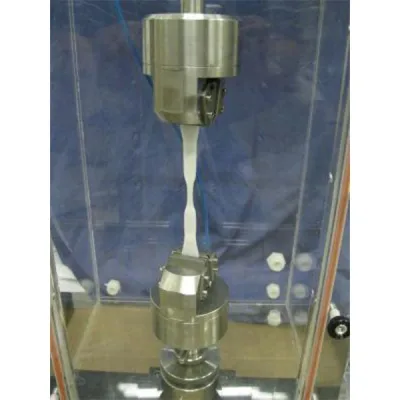
تست خستگی | FatigueTest
#تست خستگی#آزمون خستگی#آزمایش خستگی#fatigue tests#فتیگ تست#تست فتیگ #jsj osj'd#jsj tjd'
آزمون خستگی | Fatigue Test
از داده های آزمون خستگی جهت تعیین خصوصیات فیزیکی مورد نیاز در صنایع گوناگون مانند هوافضا، نفت و گاز و پزشکی استفاده می شود.
- فرآیند خستگی در بسیاری از قطعات و ماشین آلات صنعتی، موتورها، واگن ها، ریل ها، پل ها، هواپیماها رخ می دهد.
- سطوح جاده، آسفالت یا سیمان نیز با تنش اعمالی از سوی وسایل نقلیه دچار خستگی و فرونشست می شوند.
- تمامی ژنراتورها که با نیروی بخار و پیستون به حرکت در می آیند و توربین هایی که در صنایع آبی یا هسته ای استفاده می شوند به دلیل روشن و خاموش های مکرر تحت چرخه های خستگی زیاد بار و تنش قرار دارند.
تمامی موارد ذکر شده تنها بخش کوچکی از تاثیر خستگی بر ماشین آلات و صنایع را نشان می دهد.
در مجموعه آزمایشگاه های سنجش و پایش کیاژن فارما، تست خستگی برای توصیف خصوصیات فیزیکی و مکانیکی محصولات و رفتار آن ها در شرایط تحمل بارهای متناوب استفاده می شود.
#تست خستگی#آزمون خستگی#آزمایش خستگی#fatigue tests#فتیگ تست#تست فتیگ #jsj osj'd#jsj tjd'
توضیحات محصول


#تست خستگی#آزمون خستگی#آزمایش خستگی#fatigue tests#فتیگ تست#تست فتیگ #jsj osj’d#jsj tjd’
استاندارد های زیست سازگاری | References
ISO 10993-2: Biological Evaluation of Medical Devices – Animal welfare requirements.
ISO 10993-5: Biological Evaluation of Medical Devices – Tests for in vitro cytotoxicity.
ISO 10993-6: Biological Evaluation of Medical Devices – Tests for local effects after implantation.
ISO 10993-7: Biological Evaluation of Medical Devices – Ethylene oxide sterilization residuals.
ISO 10993-10: Biological Evaluation of Medical Devices – Tests for skin sensitization.
ISO 10993-11: Biological Evaluation of Medical Devices – Tests for systemic toxicity.
ISO 10993-12: Biological Evaluation of Medical Devices – Sample preparation and reference materials.
ISO 10993-22: Biological Evaluation of Medical Devices – Guidance on nanomaterials.
ISO 10993-23: Biological Evaluation of Medical Devices – Tests for irritation.
OECD Test No. 401: Guidelines for the Testing of Chemicals – Acute Oral Toxicity.
OECD Test No. 402: Guidelines for the Testing of Chemicals – Acute Dermal Toxicity.
OECD Test No. 403: Guidelines for the Testing of Chemicals – Acute Inhalation Toxicity.
OECD Test No. 404: Guidelines for the Testing of Chemicals – Acute Dermal Irritation/Corrosion.
OECD Test No. 405: Guidelines for the Testing of Chemicals – Acute Eye Irritation/Corrosion.
OECD Test No. 406: Guidelines for the Testing of Chemicals – Skin Sensitisation.
OECD Test No. 414: Guidelines for the Testing of Chemicals – Prenatal Developmental Toxicity Study.
OECD Test No. 416: Guidelines for the Testing of Chemicals – Two-Generation Reproduction Toxicity.
OECD Test No. 417: Guidelines for the Testing of Chemicals – Toxicokinetics.
OECD Test No. 424: Guidelines for the Testing of Chemicals – Neurotoxicity Study in Rodents.
OECD Test No. 426: Guidelines for the Testing of Chemicals – Developmental Neurotoxicity Study.
OECD Test No. 427: Guidelines for the Testing of Chemicals – Skin Absorption: In Vivo Method.
OECD Test No. 428: Guidelines for the Testing of Chemicals – Skin Absorption: In Vitro Method.
OECD Test No. 429: Guidelines for the Testing of Chemicals – Skin Sensitisation.
OECD Test No. 432: Guidelines for the Testing of Chemicals – In Vitro 3T3 NRU Phototoxicity Test.
OECD Test No. 440: Guidelines for the Testing of Chemicals – Uterotrophic Bioassay in Rodents.
OECD Test No. 441: Guidelines for the Testing of Chemicals – Hershberger Bioassay in Rats.
OECD Test No. 451: Guidelines for the Testing of Chemicals – Carcinogenicity Studies.
OECD Test No. 452: Guidelines for the Testing of Chemicals – Chronic Toxicity Studies.
OECD Test No. 456: Guidelines for the Testing of Chemicals – H295R Steroidogenesis Assay.
OECD Test No. 471: Guidelines for the Testing of Chemicals – Bacterial Reverse Mutation Test.
OECD Test No. 478: Guidelines for the Testing of Chemicals – Rodent Dominant Lethal Test.
OECD Test No. 484: Guidelines for the Testing of Chemicals – Genetic Toxicology: Mouse Spot Test.
OECD Test No. 489: Guidelines for the Testing of Chemicals – In Vivo Mammalian Alkaline Comet Assay.









دیدگاهها
هیچ دیدگاهی برای این خدمت نوشته نشده است.